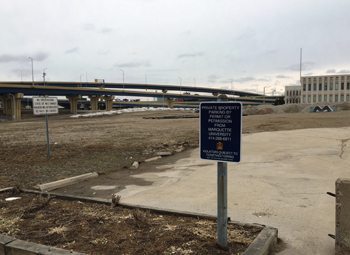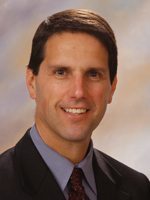The 12-acre site along West Michigan Street where Marquette University plans to erect its proposed $120 million Athletic Performance Research Center is one of Milwaukee’s most visible dead zones.
Bordered to the south and west by the Marquette Interchange, the lot is a sparse grass field with several piles of gravel clustered together near an old parking lot and signs that read “no trespassing” lining the sidewalk.
Between 2017 and 2018, the lot will be transformed into the Marquette Athletic Performance Research Center, a 250,000- to 300,000-square-foot building with a field house and laboratories bustling with students, researchers, patients and athletes.
One building that was on the site — the former site of Butch’s Old Casino Steak House — has already been demolished. An underused building at 803 W. Michigan St., the Herzing University building at 525 N. Sixth St. and the Ramada Milwaukee Downtown at 633 W. Michigan St., will also be demolished to make way for the project.
It’s a facility physiologists from Marquette and the Aurora Research Institute envision as an international destination for research that explores the limits of human performance and could help revitalize the city.
In January, Marquette president Michael Lovell announced Milwaukee-based Aurora Health Care had committed $40 million to the project. The Milwaukee Bucks will also be partners; however, the NBA team’s role has been less clearly defined. With Aurora’s contribution, Lovell estimated in January around $60 million had been secured for the facility.
Construction could begin in 2017, with plans to open the facility at the same time as the new Bucks arena in 2018.

And few are more enthusiastic about the project than a diverse team of researchers at Marquette, led by Australian-born exercise physiologist Dr. Sandra Hunter.
“It’s really exciting,” Hunter said. “Bringing other experts in who have similar or adjunct areas of expertise is just fantastic. Success breeds success … this could become a center of excellence in understanding human performance. It could be a destination. I think it will be really good for Milwaukee and also Wisconsin in general.”
Hunter has been researching exercise physiology for 20 years and she’s been at Marquette since 2003. In her lab are researchers from the U.S., Brazil, Iran and France. Since she arrived at Marquette, Hunter and her collaborators have received more than $7 million in funding from different organizations to conduct research on exercise and physiology. Last year, she and another researcher, Robert Fitts, received a $2.8 million grant from the National Institutes of Health to study the effect of a new exercise program for the elderly on muscle mass and fatigue.
At the new facility, she plans to conduct similar research.
“Our plan is to basically create a research environment where we can examine human performance and the limits of human performance with the understanding that exercise is medicine,” Hunter said.
She said her research team plans to explore a “broad spectrum,” and study everyone it can; from elite-level athletes to people living with disabilities to casual exercisers.
“We’re all aiming to be the highest physically-functioning person we can,” Hunter said. “We haven’t gotten into the absolute specifics yet, but … one of the university’s goals is to double research output and funding in the next five years, so this would contribute to that and attract high-end researchers.”

The university’s renewed emphasis on research is characteristic of its new president. Lovell took over in 2014 after serving three years as the chancellor of the University of Wisconsin-Milwaukee. During that time, Lovell oversaw the completion of UWM’s Innovation Campus in Wauwatosa and expanded its School of Freshwater Sciences.
In February, UWM was reclassified as a Tier 1 research institution by the Carnegie Foundation, meaning it has joined the ranks of the most active research institutions in the country, due in part to Lovell’s contributions.
That commitment to research is focused around what Hunter referred to as academic currency.
“The goal of, I think, most universities is to increase productivity, and what that looks like is publishing papers and being awarded more grants,” Hunter said. “That’s really the currency in academia. But it’s also the way the scientists relay to the world their findings. If that involves collaboration with Aurora, that’s great. It takes a village, often, to achieve some of these goals.”
Two years ago, Aurora Health Care consolidated its research programs into what is now called the Aurora Research Institute. The program encapsulates projects spread out at different research centers in Aurora’s hospitals and laboratories.
ARI includes around 900 scientists, physician scientists and support staff workers who are currently conducting 630 different research projects and more than 250 clinical trials, according to Randy Lambrecht, the institute’s senior vice president of research and academic relations.


“It’s very exciting the research that can go on in this facility,” Lambrecht said.
Like Marquette, Aurora plans to conduct research that will help raise its academic profile, especially in the areas of wellness, injury prevention, performance enhancement, cardiovascular training and innovation.
“But it’s not just publishing and it’s not just more grants, it’s really being able to translate that research into better patient care,” said Mike Lappin, chief administrative officer of Aurora Health Care. “The hope is that this facility becomes a destination for people interested in doing research … if the facility is successful, it will help us recruit and bring top talent to this area, which is obviously good for all of us.”
Lambrecht and Lappin said the research institute is still working out the details of how many researchers and project teams will work out of Marquette’s Athletic Performance Research Facility. But Lambrecht said one program, Team Phoenix, will definitely have a presence there.
Team Phoenix is a program for breast cancer survivors that studies the physical and psychological effects of treatment and uses nutrition and exercise to help survivors overcome obstacles.
“Medicine is changing these days,” Lappin said. “Health systems are designed to treat people when they’re sick, and going forward we’re trying to keep people well. With this facility we start getting real data, real outcomes … It’s still evolving, but there’s so much excitement.”


